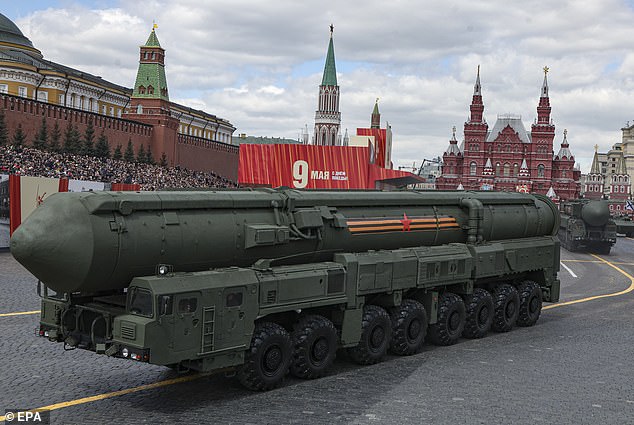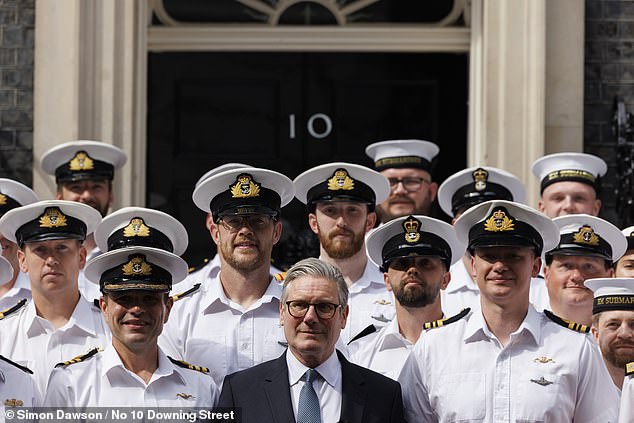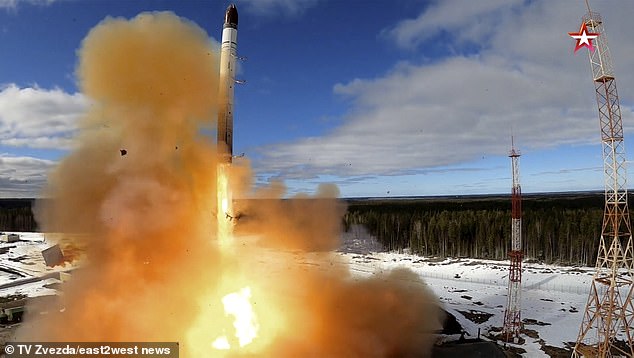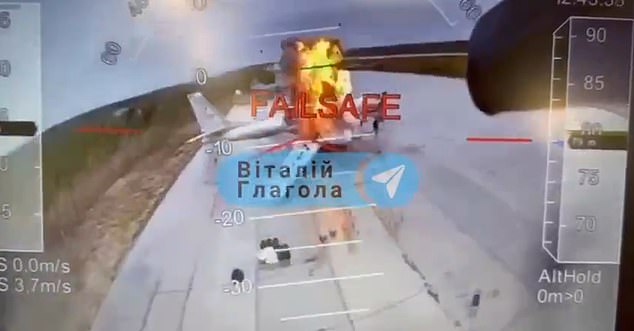A plan to prepare Britain for war against Vladimir Putin Putin has exposed this nation’s weaknesses should a significant confrontation arise.
The Strategic Defense Review (SDR), released today, features a daunting catalog of possible impacts on the United Kingdom's lifestyle. However, even with these risks in mind, senior military officials anticipate cutting costs.
The SDR, which has recommended an overhaul of the UK’s Armed Forces, also lays bare Britain’s overseas dependencies and threats.
During wartime, Britain could face assaults on both domestic and overseas military installations, strikes from long-range drones and cruise missiles, cyber-attacks that debilitate critical national structures, as well as disturbances to financial activities and global commerce pathways.
The report discloses that 95 percent of the UK's data is transmitted through underwater cables which are susceptible to attacks, and indicates that Britain depends on imported goods for 46 percent of its food supply.
'It states: 'Submarine pipelines and communication cables are essential for maintaining everyday national activities. The marine environment is becoming more susceptible to threats. Consequently, the Royal Navy needs to be ready to prevent maritime events akin to the sabotage of the' Nord Stream 2 gas pipeline and the cutting of undersea data cables in UK and international waters’.
In recent times, up to 77 percent of the United Kingdom's natural gas imports have been sourced from Norway. Therefore, should this Scandinavian country become vulnerable, the U.K.'s energy supply could be severely disrupted.
The Strategic Defence Review, penned by ex-NATO Secretary-General Lord Robertson, retired General Sir Richard Barrons, and Russian specialist Fiona Hill, was dubbed today as the most significant shift in defense strategy in 150 years.
This outlines technologies reshaping warfare including artificial intelligence, robotics, advanced accuracy systems, directed energy weaponry, hypersonic missiles, space-based assets, quantum mechanics, cyber threats, and engineered biology.


For many years, the Royal Navy and the Army, and more recently the Royal Air Force, have operated independently in terms of training and equipping their personnel. However, they are now set to integrate like never before.
Although the plan does not call for a complete merger, the services will essentially transform into an 'Integrated Force'.
The SDR suggests that this approach will be more efficient than keeping separate 'silos' for the Army, Royal Navy, and Royal Air Force.
It says: ‘In practice, the single services have largely evolved separately in terms of design, equipment and training.
'The outcome is a combined force that comes together solely on the battleground. The efficacy of the military during missions depends on the resources allocated to each branch upon arrival, not from cohesive strategic planning and execution.'
The diminishing status of the Army, Royal Navy, and Royal Air Force as separate entities will probably ignite intense discussion, a sentiment underscored by the terminology used in the report.
The individual services receive minimal mention, while the recently established Integrated Force is referenced frequently.
Today afternoon, James Cartlidge, theShadow Defence Secretary, characterized the SDR as 'an empty wishlist because of financial limitations.'
He informed the House of Commons: "Today, the Prime Minister could not provide a timeline for reaching 3 percent [of GDP], as the Treasury has yet to approve the plan."
'To achieve this, the Treasury will need to include several billion pounds worth of reductions from current MoD projects.'
'The SDR has postponed all major decisions regarding current capabilities. The great disappointment with this unraveling of the SDR is that it presented a remarkable chance to revamp our military forces at a time when global threats are increasing.'
‘For the past year the Treasury has used the SDR to effectively put MOD procurement on hold, absolutely shameful when we need to rearm at pace.
'Our armed forces merit more than this. The government has come up with an outdated, insufficiently funded, and unimpressive SDR.'
The sections of the SDR focus on areas such as land, sea, air, cyberspace, and outer space instead of being organized by service branch.
In its role within the land sector, the SDR anticipates that the Army will provide 'a tenfold boost in lethal capability'.
However, this objective must be met with only a slight rise in the Army’s size—from 73,000 to 76,000 regular troops constituting the permanent strength. The document acknowledges there is a 'valid argument for modestly boosting regular personnel counts whenever additional funds become available.'
The SDR indicates that fewer soldiers will undergo parachute training. Currently, the Parachute Regiment consists of three active-duty battalions; however, the report states, 'the parachute capability and capacity ought to concentrate on experts and just one battalion group'.
As for the Royal Air Force, it will offer the 'Integrated Force' the fastest way to attack targets.
The report urges the RAF to enhance efficiency and utilize civilian aircraft for tasks that do not necessitate military capabilities.
As the Mail disclosed last week, the RAF plans to ' invest in autonomous collaborative platforms (ACPs)' to safeguard older aircraft and vehicles.
The Red Arrows demonstration squadron will need to seek out new aircraft since the report suggests substituting the Hawk T1 and T2 planes with a 'budget-friendly advanced jet trainer'.
Alarming as it may be, the Royal Navy seems poised to shift toward becoming more 'affordable.' The document further suggests that the service ought to 'investigate different methods for maintaining a well-balanced and economically viable naval force.'
Admirals should utilize 'commercial ships' for transport in areas without enemy presence and collaborate with allies on logistics issues.
The United Kingdom’s two £7 billion aircraft carriers are anticipated to become more adaptable, featuring modifications that will enable them to launch long-range missiles from their decks and support an increased number of unmanned vehicles.
Sea drones will also take up a multitude of roles that are currently undertaken by sailors, such as mine hunting.
The SDR focuses on homeland defense and engagement within the Euro-Atlantic sphere rather than prioritizing expeditionary operations or aims to influence the broader global security landscape.
This shows a significant shift from the promotion of a 'Pacific pivot' in the UK's military strategy as late as 2021.
The SDR has put forward 62 recommendations, and the government ministers have agreed to fully endorse them all.
The purpose behind it was to ready this nation for potential confrontation with an adversary like Russia within this decade.



It stresses the importance of the UK’s contribution to Nato. In future, all aspects of preparation for conflict, such as training and procurement, will be predicated on the needs of the defence alliance.
Regarding technology, the assessment indicates that dominance on the battleground won’t stem from one specific technological advancement but rather from integrating current capacities with various upcoming innovations which encompass:
AI, machine learning, and data science
The review indicates that these technologies will enhance the quality and speed of decision-making as well as boost operational efficiency for Britain’s military, along with its allies and adversaries.
Robotics and autonomy
The battlefield of the present, in Ukraine, is dominated by uncrewed and autonomous capabilities. For example, Ukraine’s devastating attack on Russian airfields was delivered by drones. Uncrewed platforms will also integrate with manned aircraft and vehicles to generate mass and lethality.
Enhanced precision weapons
These distant objectives can now be hit with increased precision from even farther away.
Directed energy weapons
Systems like the UK’s Dragon Fire, an advanced laser-based ground-to-air system under development by experts at Porton Down in Wiltshire, have the potential to save millions of pounds in ammunition costs. Additionally, their precision helps minimize collateral damage.
Hypersonic missiles
The United Kingdom is working on rocket systems capable of traveling faster than five times the speed of sound, potentially providing extended reach and enhanced capability to bypass defense mechanisms.
Space-based capabilities
According to the SDR, nearly 20 percent of the country's GDP depends on satellite services, highlighting space as a crucial component of national infrastructure and a focal point for increasing global rivalry. A significant interruption to these satellites could result in an approximate loss of £1 billion daily for the UK economy. Additionally, harm to the nation's satellites would severely impact missile operations and communication capabilities during combat scenarios. The document urges the government to swiftly enhance the 'resiliency' of its military space technologies. It proposes acquiring ground-based sensors and anti-satellite weaponry; however, specifics have not been disclosed.
Quantum
Advances in quantum computing offer the potential for allies and adversaries to break encryption, making secure communications more challenging. Quantum technologies also have the potential to reduce dependency on satellite-based GPS which is vulnerable to interference and hacking.
Cyber threats
The report cautions that addressing cyber threats will grow more challenging as technology advances, leaving government agencies, defense equipment, and communication systems progressively at risk.
Engineering biology
Progress in health improvement, prosthetic upgrades, and supplements might boost soldier effectiveness during warfare. According to the document, this may also include potential developments in high-energy substances and explosives. Additionally, it outlines risks involving novel harmful agents like deadly microbes along with various instruments capable of widespread devastation.
Read more
Posting Komentar